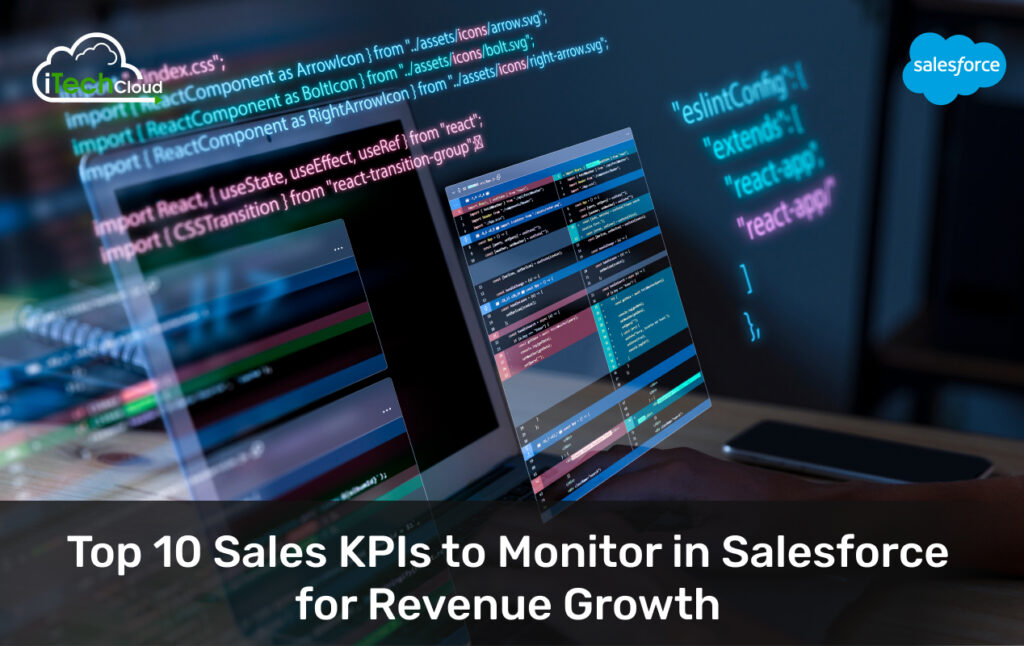Top 10 Sales KPIs to Monitor in Salesforce for Revenue Growth

Salesforce is a powerful CRM platform that helps businesses track, analyze, and optimize their sales performance. To drive revenue growth, sales teams must monitor key performance indicators (KPIs) that provide actionable insights into their sales pipeline, customer engagement, and overall efficiency.
In this comprehensive guide, we’ll explore the top 10 sales KPIs to monitor in Salesforce to maximize revenue growth, improve forecasting accuracy, and enhance sales productivity.
Table of Contents
1. Monthly Sales Growth
What It Measures:
Monthly sales growth tracks the percentage increase or decrease in revenue from one month to the next.
Why It’s Important:
- Helps assess short-term revenue trends.
- Identifies seasonal fluctuations.
- Allows for quick adjustments in sales strategies.
How to Track in Salesforce:
- Use Salesforce Reports & Dashboards to compare monthly revenue.
- Set up trend charts to visualize growth patterns.
- Salesforce Analytics for deeper insights.
Best Practices:
- Compare growth against industry benchmarks.
- Investigate sudden spikes or drops in revenue.
2. Sales Pipeline Value
What It Measures:
The total dollar value of all open opportunities in the sales pipeline.
Why It’s Important:
- Predicts future revenue potential.
- Helps in resource allocation and forecasting.
- Identifies pipeline gaps early.
How to Track in Salesforce:
- Use Pipeline Reports in Salesforce.
- Monitor weighted vs. unweighted pipeline.
- Set up Salesforce Forecasts for predictive insights.
Best Practices:
- Regularly clean up stale opportunities.
- Focus on high-probability deals to improve accuracy.
3. Average Deal Size
What It Measures:
The average revenue generated per closed deal.
Why It’s Important:
- Helps in pricing strategy optimization.
- Identifies upsell/cross-sell opportunities.
- Guides sales teams toward higher-value deals.
How to Track in Salesforce:
- Create a report on closed-won opportunities.
- Use Salesforce Dashboards to track trends.
Best Practices:
- Segment by product, region, or sales rep.
- Encourage larger deal sizes through bundling.
4. Win Rate (Close Rate)
What It Measures:
The percentage of opportunities that convert into closed-won deals.
Why It’s Important:
- Measures sales team effectiveness.
- Identifies bottlenecks in the sales process.
- Helps forecast revenue more accurately.
How to Track in Salesforce:
- Use opportunity reports with win/loss analysis.
- Filter by sales rep, product, or region.
Best Practices:
- Improve win rates with better qualification (e.g., BANT framework).
- Train reps on objection handling.
5. Sales Cycle Length
What It Measures:
The average time taken to close a deal from initial contact.
Why It’s Important:
- Longer cycles may indicate inefficiencies.
- This aids in predicting and organizing resources effectively.
How to Track in Salesforce:
- Use Salesforce Reports on opportunity stages.
- Analyze stage duration metrics.
Best Practices:
- Shorten cycles with automation (e.g., Salesforce CPQ).
- Improve lead qualification to reduce delays.
6. Lead Conversion Rate
What It Measures:
The percentage of leads that turn into paying customers.
Why It’s Important:
- Evaluates marketing and sales alignment.
- Helps optimize lead nurturing strategies.
How to Track in Salesforce:
- Use lead reports with conversion tracking.
- Integrate with Marketing Cloud for attribution.
Best Practices:
- Implement lead scoring to prioritize high-quality leads.
- Align sales and marketing on lead definitions.
7. Customer Acquisition Cost (CAC)
What It Measures:
The total cost of acquiring a new customer (marketing + sales expenses).
Why It’s Important:
- Ensures profitability by comparing CAC to customer lifetime value (LTV).
How to Track in Salesforce:
- Integrate with financial tools (e.g., Tableau CRM).
- Use Salesforce Campaign ROI reports.
Best Practices:
- Optimize marketing spend based on CAC.
- Focus on high-converting channels.
8. Customer Lifetime Value (LTV)
What It Measures:
The total revenue expected from a customer over their lifetime.
Why It’s Important:
- Helps prioritize high-value customers.
- Guides retention and upsell strategies.
How to Track in Salesforce:
- Use Salesforce CPQ for subscription tracking.
- Analyze repeat purchase behavior.
Best Practices:
- Increase LTV through loyalty programs.
- Reduce churn with proactive engagement.
9. Quota Attainment
What It Measures:
The percentage of sales reps meeting or exceeding targets.
Why It’s Important:
- Identifies top performers and underperformers.
- Helps in incentive planning.
How to Track in Salesforce:
- Use performance dashboards.
- Compare actual vs. target revenue.
Best Practices:
- Provide coaching for low-performing reps.
- Adjust quotas based on market conditions.
10. Churn Rate
What It Measures:
The percentage of customers lost over a given period.
Why It’s Important:
- High churn indicates customer dissatisfaction.
- Impacts recurring revenue (critical for SaaS businesses).
How to Track in Salesforce:
- Use Subscription Analytics.
- Monitor customer health scores.
Best Practices:
- Implement retention strategies (e.g., success plans).
- Proactively address customer issues.
My Takeaway: Salesforce for Revenue Growth
Monitoring the right sales KPIs in Salesforce is essential for driving sustainable revenue growth. By focusing on metrics like lead conversion rate, opportunity win rate, sales cycle length, and forecast accuracy, businesses gain actionable insights to refine strategies and boost performance. Tracking these KPIs empowers sales teams to identify bottlenecks, enhance customer engagement, and prioritize high-value opportunities.

